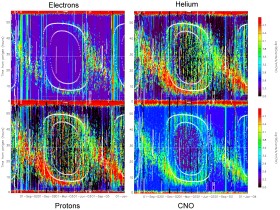|
Cluster Mission Extended
 Four years after the start of its operations phase, the Cluster Mission has
been extended an additional four years, to the end of 2009. This 4-spacecraft
mission has made multi-point measurements of the plasma environment in all
the important regions of the Earth's magnetosphere, at scales of a few
hundred to several thousand kilometres. In the extended mission, it will
carry out the first multi-scale investigations of the magnetosphere, with
simultaneous measurements at distances of a few hundred to 10000 kilometres.
Four years after the start of its operations phase, the Cluster Mission has
been extended an additional four years, to the end of 2009. This 4-spacecraft
mission has made multi-point measurements of the plasma environment in all
the important regions of the Earth's magnetosphere, at scales of a few
hundred to several thousand kilometres. In the extended mission, it will
carry out the first multi-scale investigations of the magnetosphere, with
simultaneous measurements at distances of a few hundred to 10000 kilometres.
 See ESA Website for additional informations.
See ESA Website for additional informations.
The energetic particle spectrometer RAPID on board the Cluster
spacecraft measures electrons, protons, and heavier ions above 30
keV. The diagrams show summaries of the particle intensities over a
year and a half. The vertical scale is the orbit phase, such that the
top and bottom are perigee (closest point to the Earth, 24,000 km)
while the middle line is apogee (furthest away, 120,000 km). The
horizontal scale is time from June 2001 to January 2004, as the orbit
plane moves from the geomagnetic tail, to the dayside, and back to the
tail. The ellipses are the positions of the bow shock (inner) and
magnetopause (outer). The centre of each diagram is in the solar wind,
between the Earth and Sun. These diagrams show clearly how the plasma
sheet in the tail regions is painted out by the energetic particles
(on the sides of the diagrams), how the energetic electrons are absent
in the solar wind, and how the dawn-dusk asymmetry at the magnetopause
is opposite for negatively charged electrons and positively charged
ions, an effect expected from their differing drift directions.
|
|
|
|
|
 |
|
|
|
|
